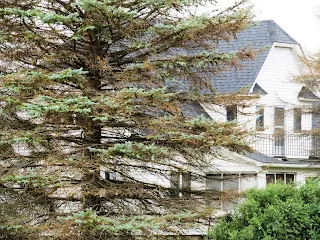 |
| Trees on left side of photo are approximately 50' west of the building. I am sure the little seedlings looked like they were a mile away from the house when they were first planted. |
 |
| The brown trees on the left side of this photo are approximately 50' south of the building. |
Evergreens are an obvious choice because they do a great job breaking the wind during the coldest months of the year.
Spruce trees are generally preferred because they do not drop their bottom branches while pine trees tend to be "self-pruning".
Of the spruce trees, Colorado Blue Spruce is often considered the most ornamental.
They are dying in droves
Higher elevations in the state of Colorado alternates between hot-and-dry and cool-and-moist. Furthermore, populations of trees are separated from others of their species by dry south facing slopes and valleys that are inhospitable to spruce trees. Colorado Blue Spruce thrives in Colorado.
It does well in the mid-West...for a while. And then they die, becoming 50' tall, pitch soaked bundles of tinder.
 |
| Image from HERE |
Zone 1 extends 30 feet* out from buildings, structures, decks, etc.
- Remove all dead plants, grass and weeds (vegetation).
- Remove dead or dry leaves and pine needles from your yard, roof and rain gutters.
- Trim trees regularly to keep branches a minimum of 10 feet from other trees.
- Remove branches that hang over your roof and keep dead branches 10 feet away from your chimney.
- Relocate wood piles into Zone 2.
- Remove or prune flammable plants and shrubs near windows.
- Remove vegetation and items that could catch fire from around and under decks.
- Create a separation between trees, shrubs and items that could catch fire, such as patio furniture, wood piles, swing sets, etc.
 |
| The goal is to use space to reduce the likelihood of the fire getting into the canopy. It is no accident that they chose an evergreen for the illustration. |
Zone 2 extends 100 feet out from buildings, structures, decks, etc.
- Cut or mow annual grass down to a maximum height of 4 inches.
- Create horizontal spacing between shrubs and trees. (See diagram)
- Create vertical spacing between grass, shrubs and trees. (See diagram)
- Remove fallen leaves, needles, twigs, bark, cones, and small branches. However, they may be permitted to a depth of 3 inches.
The upside is that the roofs are steep and unlikely to collect dead needles even if the wind (which generally comes from the west-southwest) blows them onto the roof. Also, this house does not have eve-troughs which can collect tinder. Furthermore, the yard is very well maintained.
I talked with a fire-fighter and he said that property can be replaced. While I agree, I loath seeing unaddressed hazard. Sometimes the smoke alarms don't go off in time (CO got the residents). Sometimes the residents are elderly and not very mobile. Sometimes fire-fighters are killed or injured in fires.
So, in my humble opinion, removing conifers (evergreens with needles) that are within 100 feet of your house is a smart move. You might be OK with them a little bit closer on the sides that are leeward of your house when considering the prevailing winds, but don't let them hang over the structure.
 |
| Where do you think the embers from Billy and Darlene's bonfire are likely to end up if they land on your roof. Yup, sure enough, they are going to roll right into those drifts of pine-straw. |



No comments:
Post a Comment
Readers who are willing to comment make this a better blog. Civil dialog is a valuable thing.